A Buyer's Guide to Plastic Toy Soldiers
written by Luke Honey
The appeal of the toy soldier is as old as recorded history. Toy soldiers, or at least, more accurately, 'soldier figures in miniature,' have been discovered in the tombs of the Pharaohs in Ancient Egypt. The Romans manufactured miniature soldiers in lead- found in excavations in Spain, Britain, Germany, and Ethiopia- and intended, possibly, as children's playthings.
Super Deetail Paratroopers Holy Grail Set (detail). Image: Sclight / License: CC BY-SA 4.0
Tech War Games: Lead or Plastic?
But for those born in the mid-to-late 20th century, the toy soldier still holds a romantic, nostalgic appeal, especially for adult collectors, reviving past glories on the nursery floor, at odds with the brutal reality of the nuclear age. In 1893, William Britain- a mechanical toy and brass clock maker- pioneered an ingenious technique to cast toy soldiers from molten lead, leaving a hollow centre and saving on raw materials. From an economic perspective, this put his newly founded toy soldier company one step ahead- enabling them to take on their more expensive European rivals, such as Heyde of Germany or Mignot of France. Britains carried on producing their lead soldiers until as late as 1966, when a ban on lead-based paint, combined with rising costs, forced the firm to switch production to the British colony of Hong Kong, where Britains continued to manufacture toy soldiers- but from plastic.
Do You Have a Collection of Toy Soldiers and Wonder What Is It Worth? Submit It for Appraisal Here!
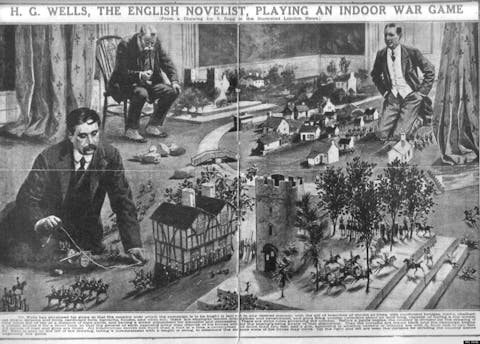
H. G. Wells playing a war game with W. Britain lead toy soldiers according to the rules of "Little Wars". Drawing by S. Begg in the Illustrated London News. Image: Public domain
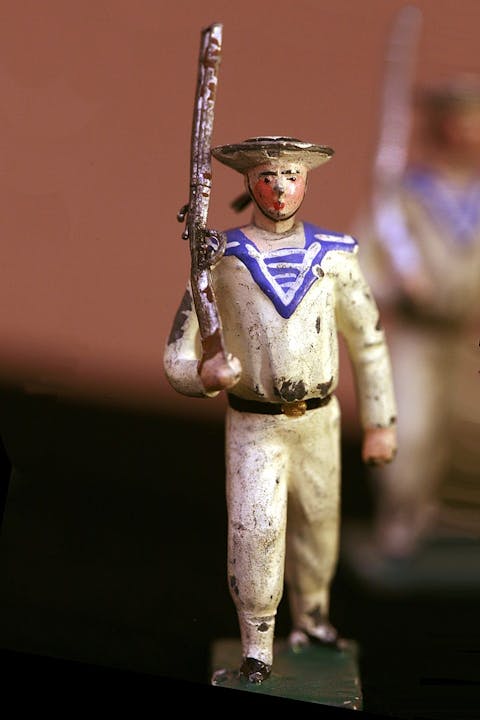
Toy soldiers: French sailors wearing the uniforms in use during the Sino-French War. Made by Mignot C.B.G. between 1876 and 1902. Painted moulded lead. On display at Paris naval museum. Image: Rema / License: CC BY-SA 2.0
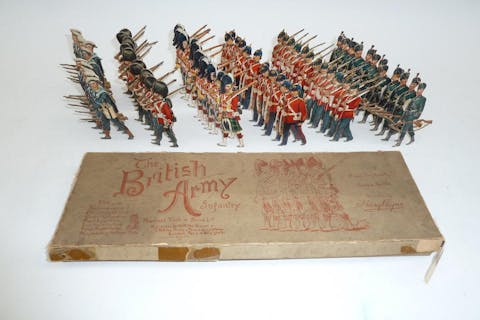
Heyde No.2 Size English Infantry in Foreign Service Order. Image: Bonhams
Plastic has been around for longer than one might think. Celluloid was developed as early as 1870- from the plastification of nitrocellulose by camphor. And in 1907, bakelite replaced naturally derived materials (such as tortoiseshell) in industrial production. In 1926, Otto and Max Hausser, originally doll manufacturers of Stuttgart, came up with the name "Elastolin" for their range of toy soldiers, made from a composition material: derived from a mixture of sawdust, glue and kaolin clay, moulded around a wire frame. In 1947, Starlux, the famous French toy manufacturer, sold its first toy soldiers produced from cellulose acetate. During the 1950s, 60s and 70s, Starlux produced beautifully designed and historically detailed figures- including Medieval knights and Napoleonic infantry and cavalry in hard plastic. By the early 1950s, other manufacturers- in Europe, America and the United Kingdom- were turning to figures produced by plastic injection moulding, ensuring even quicker and cheaper production. Traditional companies, such as John Hill & Co. (which fell into administration in the early 1960s), lost out to their more competitive and innovative rivals due to their failure to adapt. In the United States, the distinguished toy firm, Louis Marx & Co., dominated the market in plastic toy soldiers, specialising in boxed display sets, now avidly collected.
Related: Learn About Toys
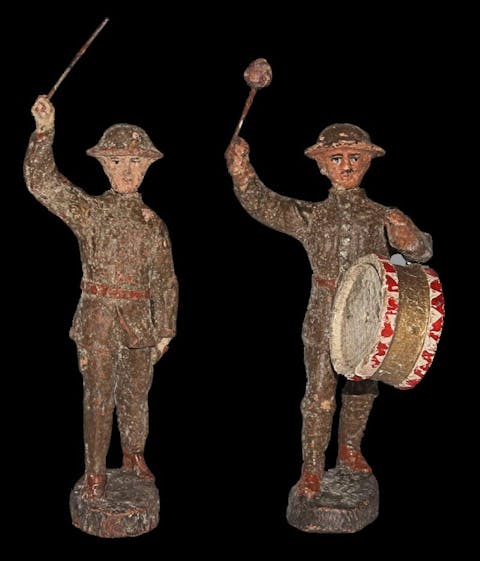
Elastolin World War One Toy Soldiers. Early 20th century. Image: Value My Stuff
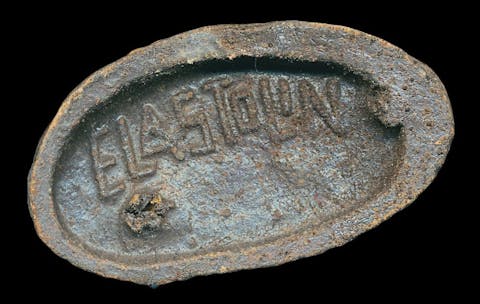
Elastolin World War One Toy Soldiers- signature. Early 20th century. Image: Value My Stuff
Toys to play with or to collect?
It's not clear which firm produced the first plastic toy soldiers. In Britain, Airfix- the beloved manufacturer of affordable plastic kits- made toy soldiers from brittle plastic as early as 1947. Timpo, Cherilea and Crescent began to manufacture plastic toy soldiers around 1955, using traditional hollow-cast lead moulds converted for plastic. Zang Products (later Herald) produced a successful plastic toy soldier range in the early 1950s, adopting the evocative tradename 'Herald' in 1953. These early Herald figures are relatively easy to find and include mounted Life Guards, Cowboys and Indians, kilted Highland infantry and American and British troops from the Second World War. In 1955, Britains bought a controlling interest in Herald Miniatures, finally buying out the company in 1959: the Herald brand remained part of the Britains range until its demise in the early 1980s. And in 1958, Britains introduced their innovative 'Swoppets' range in moulded plastic. This ingenious new series featured moving, interchangeable parts: an imaginative child might turn a head to one side or swap a sword, cap or Colt pistol (removed from a holster) from one figure to another. The range also included a set of superb 'Wars of the Roses' heraldic knights, in full armour, designed by master toymaker Roy Selwyn-Smith, and quite possibly the 'jewel in the plastic crown'.
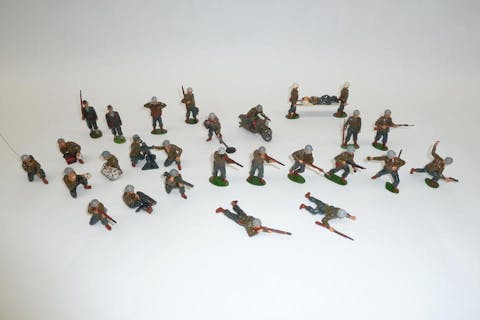
Timpo G.I.S, U.S.Infantry in Action, 1952. Image: Bonhams

Vintage plastic Trojan War figure by Herald. Image: Public domain
Which Army Do You Want to Be?
But perhaps the most collectable- and popular- of all the plastic toy soldiers produced in the mid-to-late 20th century is the Britains 'Deetail' range, first marketed in 1971 (to replace the Swoppet range) and manufactured (with variations) until the mid-1990s. Prices remain affordable; potentially, they're antiques of the future. The Deetail series featured hand-painted plastic figures mounted on painted metal bases cast from 'Zamak', a zinc alloy. Plastic moulding encouraged realistic modelling, with life-like poses and a sense of dynamic movement, in comparison to the relatively stiff pose of the traditional lead soldier.
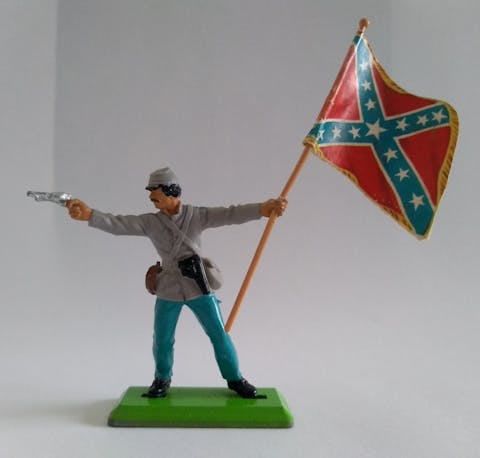
Britains Deetail Confederate NCO with flag and pistol. Image: Sclight / License: CC BY-SA 4.0
Another clever marketing innovation was the sale of boxed sets featuring two opposing sides- encouraging creative children to recreate a historical conflict of their choice: French vs British (Battle of Waterloo), Cowboys vs Indians, French Foreign Legion vs Arab Desert Warriors (inspired, clearly, by Hollywood's 'Beau Geste'), Mexican Bandits vs Apaches, Medieval Knights vs Turks, Union vs Confederacy- all painted (if slightly crudely) in vivid, bright colours. The American Civil War became a popular theme, especially in the years following the anniversary of that tragic struggle in the mid-1960s; Britains likewise cashed in on the bicentenary of the American Revolutionary War with their commemorative 'American War of Independence limited edition set, revived from the Swoppet range in 1976. Britains sold affordable single figures, displayed in toy shops counter packs or in attractive boxed sets: the latter more suitable for a Christmas or birthday present, as they were relatively expensive compared to the figures made by rivals such as Airfix or Timpo. Britains also produced exciting accessories and buildings to complement their tiny armies: artillery (including a Gatling Gun, an early machine gun), trees, castles and siege equipment, Wild West rafts, forts and cowboy saloons, stagecoaches and armoured cars.
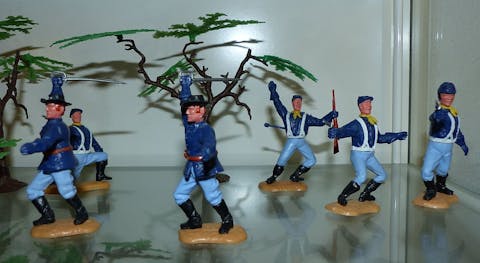
Timpo, Soldiers of the Confederate States Army. Image: Stefan97 / License: CC BY-SA 4.0
Toy soldiers- The Real Collector’s Deal
In the early 1990s, Britains switched production to China, and the Deetail range continued until 1998. Inevitably, the classic sets, made between 1971 and 1978, attract the keenest aficionados: collectors like to relive the nostalgia of their youth, and sets- in immaculate condition, 'mint and boxed' (as seen on a frosty Christmas morning in the mid-1970s) will always command a premium. As regards research, Britain's original printed catalogues are readily available online- an invaluable resource for new enthusiasts attempting to build a collection. The Holy Grail of the Britains Deetail range is the Modern British Paratrooper set (more accurately described as the experimental 'Super' Deetail range) manufactured by fusing unpainted plastic parts together, creating the impression of a highly detailed painted figure. Britains produced these figures in a limited number in 1978, and it's thought that fewer than 1,000 were made. A Modern British Paratrooper set- in the characteristic yellow 'Super Deetail' box (from "the unissued pre-production sample set, no. 6314... extremely rare issue") with six figures and two war-torn trees, fetched £300 at Vectis auctions in 2011. The auctioneer described the set as "only the second example to be sold by Vectis in ten years." More recently, in 2020, another example, in a slightly squashed but original box, fetched $850 at Old Toy Soldier auctions in Pittsburgh.
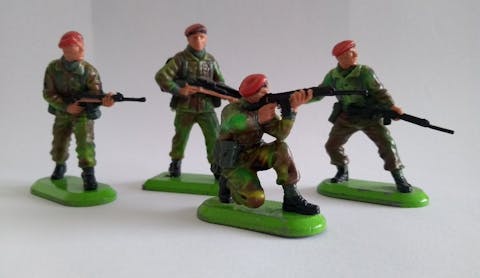
Super Deetail Paratroopers Holy Grail Set. Image: Sclight / License: CC BY-SA 4.0
How Much Does it Cost?
Prices otherwise remain affordable. The Foreign Legion set was only sold for a few years (between 1975 and 1978) and is, presumably, relatively scarce. Yet it might be possible to secure a set in good condition for a hundred pounds plus: In 2019, a Britains Deetail 'Foreign Legion vs Arabs' set, complete in box (and in a "generally very good condition"), fetched £150 at Vectis auctions, while a 1976 Wild West 'Cowboys and Indians' 'battle' set, compete with "trappers, canoe and scenic pieces", mint in box, made £120 the previous year.
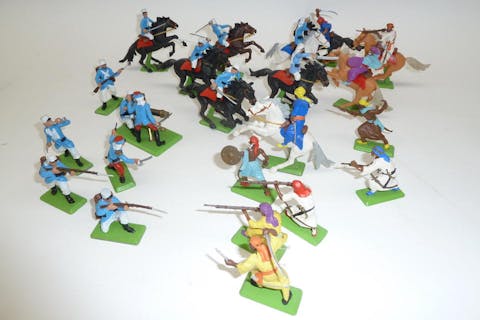
Britains Plastic Deetail French Foreign Legion and Arabs Series. Image: Bonhams
Where to Buy Toy Soldiers?
As with other vintage collectables, when it comes to the hunt, buyers have a variety of options, each with its pros and cons: typically, toy soldier shows, fairs, flea markets, car boot sales, specialist dealers and reputable toy auctioneers- and, of course, the ubiquitous online auction site. In the latter case, the mantra is, as ever, 'buyer beware', and a degree of caution and common sense is necessary. Thorough research is key in the antiques game and puts you at a distinct advantage when you're up against competitive collectors.
Submit your Toy Soldiers for Appraisal Here!
Luke Honey is a dealer in unusual decorative antiques, furniture, pictures, posters and works of art- with an enthusiasm for the "Gentleman's Library" or quirky "English Country House" look. As a former specialist at both Phillips and Bonhams, Luke has had over twenty years experience selling antique games and is considered a leading authority on old backgammon boards, antique chess sets and chess boards, gambling and racing antiques and mah jong.
Luke operates from premises in Central London, where all stock can be viewed by appointment. Items can be viewed online at his regularly updated website.

